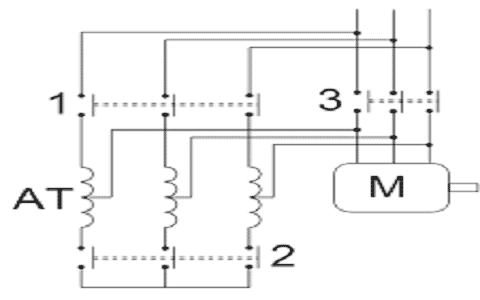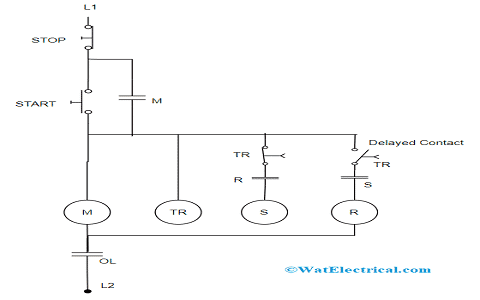Initially, let us know what an autotransformer is, an autotransformer is the electric type of transformer that works only with one winding. The word “Auto” indicates that only one coil functions independently. Here, the sections that are present in the same winding operate as the transformer’s secondary and primary windings. Whereas, the general kind of transformer has individual secondary and primary windings. And then the invention of the autotransformer starter took place in the year 1908 by Max Korndorfer in Berlin and received the patent rights for the invention of this device in the year 1914. Later on, he assigned the device patent rights to the General Electric organization. Now, this article explains autotransformer starter working, its theory, and its uses.
What is Autotransformer Starter?
In the domain of electrical engineering, this starter is the method implemented for reduced voltage soft initiation of induction motors. Even though this device was invented by Korndorfer, the motor’s initiation technique was developed and enhanced by Hilton Raymond Bacon. This device is appropriate for both the delta and star way of connected motors.
In general, the autotransformer starters are used along with squirrel cage motors which have a power rating of above 20 HP. These squirrel cage motors that are operated on full line voltage through DOL starter derives huge starting current which might impose risk on motor winding and also increases the rate of current. So, the other approach is preferred for the initiation of induction motor and is called an autotransformer starter.
This is the basic autotransformer starter principle.
Theory of Autotransformer Starter
This device is considered one of the prominent electromechanical minimized voltage starters. The prominence is credited to the truth that this kind of starter might lessen the amount of inrush current in the system to the very minimum level of all the other types of electromechanical starters. Even, the starter’s taps allow for the modification of motor torque and voltage levels which suits perfectly to start many industrial loads. The autotransformer starter can be utilized with any kind of squirrel cage induction motor where the starter’s motor has a direct connection with the secondary winding of the autotransformer.
In addition, the taps also regulate the starting voltage level and supply motor level in the phases of 50, 65, or 80% of the significant voltage. By employing an autotransformer for the initiation of the device, the line will be less than the nominal current level at the time of acceleration. When the motor is connected to a 50% tap of the autotransformer, the current is lessened by nearly 50% of the nominal current level. Whereas the line current will be 25% of the nominal current level.
As because of the lower line, autotransformer starter holds more prominence of all the types of reduces voltage starter. Here, the starter generates more amount of torque per ampere of line current when compared with any other types of voltage starter devices.
Also, when huge motors are in operation for extended time periods in the circuit, then voltage drop might take place, which leads to the destruction of electrical devices that operate on the same supply line. As we are aware that current and voltage have direct relation which is V ∞ I. When there is a reduction of supply voltage, then automatic current reduction takes place. So, there are multiple ways of reducing voltage levels.
One of the methods is to lessen the input level of voltage supplied to the motor through a transformer. A similarly reduced voltage can be supplied to the motor till it reaches the normal operational speed. When the motor’s operational speed comes to its normal functional speed, then the reduced voltage can be substituted using the mainline voltage.

Auto Transformer Starter Circuit
Though it has to be remembered that the transformer that functions the objective in those types of starter is not the general step-down transformer with unique secondary and primary windings. This transformer consists of just a winding that is used for both input and output.
Working Principle
At first, for the initiation of the motor, switches 1 and 2 will be in a closed state where this provides the motor with minimal voltage to be received from the autotransformer. The lower voltage level restricts the input current and also the motor’s torque level is reduced. The motor continually enhances its speed rate until the motor and load torque gets balanced and they come to a steady speed level.
At the balanced stage, switch 2 is in open condition and temporarily motor receives lesser voltage due to the reason that autotransformer windings perform as inductors that are in series connection with the motor. As the time is very less, the disconnection of switch 1 and connecting switch 3 is so simple where it connects the entire voltage level with the motor. Then, the speed increases rapidly and the motor reaches the maximum level of speed.
Now, the soft starting point comes to an end and the motor can initiate to be operated as complete load. The autotransformer starter is continuously needed and gets de-energized by making switch 1 to OPEN state. Through the 3-phase network, the motor gets a direct supply and to stopover, the motor, a switch is made to OPEN.
Whereas the controlling in autotransformer starter working is explained as follows:
When the device is operated by pressing the START button, then the timer (TR), shorting contractor (S), and the primary contractor (M) forms the circuit, and all these are energized. Then the motor receives a power supply from the autotransformer tappings. At the same time, the closed ‘S’ contact which is in series connection with the ‘R’ coil will be opened to obstruct S and R from getting energized.
The operation of the timer is initiated when the timing series of TR comes to an end and it comes to an OPEN state. This makes the ‘S’ contractor disconnect from the line and allows the shoring contractor to OPEN. Here, the autotransformer winding is in series connection with the same motor as the reactor and continues to operate smoothly. Then, after a minimal time gap, the TR contact gets closed, and this closes the ‘R’ run contractor and allows the connection of the motor with the mains supply. After this connection, the motor reaches to maximum speed level and then functions in normal operating conditions.

Controlling Circuit
As because of the unique time delay design, normally open contact operates only after a short time gap of normally closed contact. This time gap is most crucial for the perfect functioning of the motor without showing any damages and risks. And after pressing the STOP button, the ‘M’ main contractor gets de-energized. This removes the connection of all other devices from the power line and the circuit comes back to its normal state.
As a brief, the starting sequence is explained as:
- Initially, the start switch is closed to activate the transformer
- The motor has a connection with chosen lessened voltage tap on the autotransformer and initiates to turn and accelerate
- After some specific period of time, the start switch is opened
- Then after a delay of milliseconds, the run switch is closed
- Then motor functions at operational speed
The below tabular column shows the current and torque with three lessened voltage taps
| Current | 80% tapping | 65% tapping | 50% tapping |
| Voltage | 64% | 42% | 25% |
| Torque | 80% | 65% | 50% |
Advantages and Disadvantages
The advantages of autotransformer starter are explained as follows:
- The device is used for significant control of inrush current
- The autotransformer starter is utilized in huge motors where there will be no possibility of start by direct connection to the network. In huge motors, when the devices are initiated with substantial load, then the star-delta starter is not implemented.
- Also, the circuit has the benefit of over-starting together with a consistent transformer, where this requires to be some location completely gets detached at the time of start producing a high range of voltage impulses. This might cause a risk to the starter’s electrical insulation.
- For an effective auto transformer starter, the ratio is between the range of 65-80%
- It produces maximum torque per each ampere of supply current
- Here, the rate of motor current is more than the supply current
- This approach is more appropriate for extended starting periods
- In this, starting voltage can be altered by choosing exact tapping on the autotransformer
Disadvantages
The disadvantages of autotransformer starter are explained as follows:
- The circuit designing is more complicated, and it needs a comparatively high-cost autotransformer
- As because of the device huge size, it may not be feasible to include a Korndorfer starter in the already existing machine when there is space inadequacy
- It has a minimum power factor
Auto Transformer Starter Uses
The applications of autotransformer starter are:
- It is used for systems interconnection which operates in threshold voltage levels
- It can be utilized like a booster at the end of lengthy transmission lines to eliminate any kind of losses in the line
- Used to lessen voltage starter in the induction motors
- Implemented for the increment of incoming voltage levels
- Employed in AC feeders such as boosters to increase the specified voltage
- Employed for the activation of split ring induction and squirrel-cage induction motors
- Can be implemented in starting devices for specific types of fluorescent light fixtures
- Used in synchronous motors
Know more about Step-Up Transformer.
Know more about Electrical Contractor MCQs.
This is all about the autotransformer starter. This article has provided a detailed analysis of the autotransformer starter working principle, theory, advantages, drawbacks, and applications. Furthermore, know-how the autotransformer starter minimizes the motor’s starting torque to double the transformer’s voltage ratio.